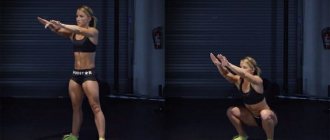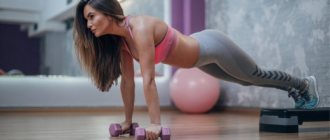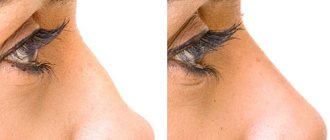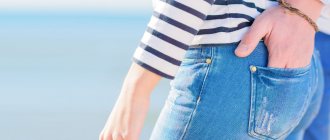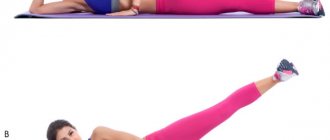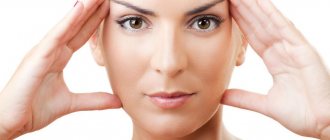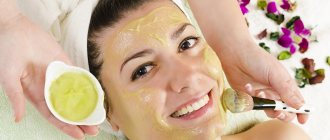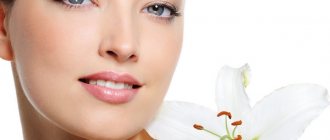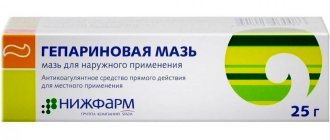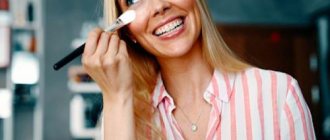My legs are like Sarah Jessica Parker . Thin, not the worst, but you can’t call them perfectly straight. I don’t know if Parker can boast of a combination of longitudinal and transverse flat feet , but this is what provided me with this shape. When I stand relaxed, my knees turn inward and my calves turn outward, and just below the knees there is quite a lot of space between my legs. And even lower, my shins meet my ankles, which are rolled inward, and form quite noticeable angles with them.
Ideal leg shape
There are many opinions regarding the correct shape of the legs, but all this is from the realm of theory. When determining curvature, specialists use A. A. Artemyev’s classification, which he proposed in 2001.
The doctor was the first to talk about the parameters of the correct form from a practical point of view. The beautiful legs have three spindle-like spaces between the inner sides of the legs. These gaps are limited by the perineum, closed knees, muscles of the upper leg and ankle (Fig. 1).
Leg straightening on the machine
The goal of the classes is to train the quadriceps femoris muscle, but not to build mass, but to work out its relief and shape.
To perform this exercise, you will need a simple leg extension machine.
The purpose of exercises on the simulator is to correct the relief and shape of the quadriceps femoris muscle.
How to do the exercise:
- Sit on the machine and first check how it is positioned: when placing your shin under the support, it should be no higher than one third of the length of the shin
- if the stop is higher or lower, set it according to your anthropometric data
At home, this exercise can be performed on a chair with weights on the shins.
Video: Straightening your legs while sitting in a machine.
Leg shape
If you go to a full-length mirror and place your feet close together, you can see three windows. If you observe such a spectacle, then begin to rejoice - your lower limbs are perfect. Otherwise, we can talk about curvature of the legs, which comes in three types.
Fig.2. a – correct shape, b – true O-curvature, c – false deformation, d – true X-curvature.
1. O-shaped. With this anatomical feature, it is impossible to bring the knees together without effort. as a result, a gap is formed in the form of the letter O, limited by the jointed ankles and groin.
2. X-shaped. In this case, it is not possible to bring the ankles together with the hips closed. We are talking specifically about a free stance, when the patient does not try with all his might to bring his legs to the correct position. 3. False. The first two types are caused by bone deformation, but in this case the bones are straight. The problem is the improper distribution of soft tissue. The legs do not meet at the top of the shins, but touch at the ankles, knees and thighs. Externally, the legs look crooked, although in fact they are not.
Artemyev believes that the true curvature of the legs occurs due to the curved bones of the lower leg, namely the tibia. In some cases, the curvature is explained by changes in the knee joint, which are caused by the anatomical features of the condyles. (Fig.3).
Rice. 3. Reducing the height of the condyle leads to axial deformation of the joint.
In the case of normal body proportions, 10-15% deviation from the articular axis is considered acceptable. But this change will cause a slight curvature of the legs, which will be considered a cosmetic defect. Practical criteria for assessing the shape of the lower extremities, which Artemyev proposed, are also needed to determine how to correct the situation.
Fig.4. Different shapes of the legs due to small axial deformations.
a) “ideal” shape of legs; b) true O - shaped deformation of the legs; c) false curvature of the legs;
d) true X - shaped deformity of the legs.
Classification and criteria proposed by Artemyev A.A. are necessary not only to determine the type of leg curvature, but also to choose a method for correcting the identified pathology.
Exercises to correct O-shaped curvature
The following exercises help with this type of curvature:
Examples of exercises to correct curvature of the legs
- Walking on the inside of the foot.
- Walking on your heels with your toes facing out.
- Squats in a “ballet” position: toes pointed out as far as possible.
- Exercises for the adductor (internal) muscles of the thigh and lower leg: free abduction of the leg to the side in a standing position;
- leg abduction with shock absorber - rubber cord;
- raising the leg to the side while standing sideways to the support;
- leg lift while lying on your side.
- Lie on the floor with your feet against the wall. When sitting down, reach your hands towards the wall.
Sports preferred for O-shaped curvatures:
- skating;
- skating skiing;
- ballet dancing;
- swimming.
How to correct crooked legs based on the shape of your legs
If you don’t want to hide imperfections, then you need to go to a surgeon. True curvature is corrected by orthopedic traumatologists during osteoplastic operations. This is not so much about eliminating a cosmetic defect as it is about preserving your health. Even a slight curvature of the bone changes the load on the joint, leading to severe diseases.
In case of false deformity, a plastic surgeon corrects the shape of the legs by injecting the patient’s own fat or installing implants. As a result, the inside of the legs becomes full, and the window between the knees and ankles disappears.
Causes
Bow legs in men and women are a rather serious problem, so many patients are interested in how to correct bow legs and why they are deformed in the first place. First, let's look at the reasons for curvature of the legs:
- Disorders in the formation of bones and joints in childhood;
- Incorrect and tight swaddling in infancy;
- Cerebral palsy;
- Excess body weight can lead to curvature even in adults.
Incorrect load distribution can provoke false asymmetry. If a person carries a bag every day in the same hand or on his shoulder, constantly sleeps on his side, or stands leaning on one limb, eventually the muscles on one side will become stronger than on the other. This point is very important when training in the gym, you need to perform all exercises symmetrically, with an equal number of repetitions on each leg.
Massage
Massage is usually performed for hallux valgus.
The specialist works on several areas:
- back – rubbing, stroking, kneading, comb-like sawing;
- lumbosacral region - stroking, light pressure or shifting, vigorous rubbing;
- buttocks – circular stroking, active rubbing, kneading with both hands, light patting;
- the back of the thighs - stroking (from the popliteal fossa to the thigh), kneading with both hands, rubbing, light blows;
- back surface of the lower leg – stroking, rubbing, kneading, vibration shocks, stretching;
- knee joint - stroking, light pressure or rubbing, clapping.
It is necessary to regularly work out the Achilles tendon, the front surface of the thighs and shins. The specialist should also pay special attention to the feet. The massage ends with stroking.
What is the problem with crooked legs and how to reduce the risks? Pain in the back, joints and neck may occur
The main problem with crooked legs is the unbalanced distribution of load not only in training, but also in everyday life. “The joints take on more than they should, and over time, pain in the joints of the legs and various problems associated with this can occur. For example, osteoarthritis,” explains rehabilitation and posture correction specialist Leonid Zasedatelev. There is also a chance that due to inadequate support, the body will also assume an irrational position, and this can lead to back and neck pain.
“When a parent decides to send their child to professional sports, not even necessarily football, they need to start with consulting a specialist. It is important to make sure that everything is in order with the child’s musculoskeletal system, because intense loads await him ahead, adds orthopedist Roman Bodio. “If we are talking specifically about football, it is important to use orthotics that protect the foot from flattening, knee pads that protect the knee joint from damage, and other stabilization methods that the doctor or coach will tell you about.”
The point with shoes is also true for adults - that’s why football players, when they donate or donate their boots to charity, always take out the individually made insoles from them. Also, in order to keep their legs healthy, it is important for children and adults not to neglect warming up, strengthen their muscles and ligaments, and consult a doctor if discomfort in their legs occurs.
“Even if a person goes to sports once or twice a week, this is also a load. And the older a person gets, the more dangerous this overload can be, because it is easier to get some kind of injury,” concludes Roman Bodio.
Reasons for the “wheel” structure of legs in girls
The girl’s legs are like wheels – not only an aesthetic flaw. The cause of the development of the defect can be considered congenital hypoplasia, provoked by fibrocystic dysplasia or neurofibromatosis. In this case, one of the legs is deformed unevenly. With congenital hypoplasia, there is a high risk of developing pseudarthrosis.
Curvature of the legs occurs due to rickets. Most often, the pathology develops in adolescence and early age, or in utero. The main cause is considered to be a deficiency of vitamin D. The formation of O-shaped legs in Blount's disease (osteochondrosis deformans) involves the curvature of the limbs at an angle.
The pathology is usually diagnosed in younger schoolchildren. In adulthood, O-shaped legs are formed against the background of deforming osteochondrosis (Paget's disease), characterized by damage to the tibia and femur. Also, curvature of the limbs can be caused by excess weight, flat feet and osteochondrosis.
Shoes
Shoes will not help straighten your feet. With its help you can hide the defect. Experts recommend abandoning ankle boots and short shoes in the autumn-winter period. Visually they will make the shin more crooked.
When choosing shoes you need to be guided by the following criteria:
- Over the knee boots will help hide the curvature of the legs;
- stocking boots should be in a contrasting color with leggings or tights;
- It is best to purchase shoes from suede and velor.
For girls with crooked legs, light boots without sparkles, sequins and other decorations are suitable. For women with full legs, experts advise purchasing black, dark brown, gray or dark blue tights. Boots must have a straight and wide top. If your legs are truly curvature, it is better to avoid shoes with heels, platforms, or tread soles. Pointed-toe shoes are also not suitable.
Correction belts
Corrector belts help straighten your legs in a few weeks.
User manual:
- 3 belts (for hips, knees and shins) need to be laid out on a flat surface;
- place a small pillow between your knees;
- tighten the knee and shin straps;
- Having assumed a comfortable position, fasten the hip belt.
The corrector should be worn daily for 2-3 hours. The belt should not be too tight: if a person experiences discomfort, then the corrector should be loosened slightly. Experts recommend measuring the distance between the right and left limbs before using the corrector.
A positive result will be noticeable after 3-4 weeks of daily wear. While wearing the harness, you can perform simple exercises to straighten your legs (lifting your torso and legs). The straps are made of lycra and neoprene. They vary in length: the shin strap is 53 cm, the knee strap is 62 cm, and the shin strap is 70 cm.
How to determine the type of curvature?
The most reliable method to distinguish between false and true curvature is radiographic examination of the lower extremities. This technique will allow you to visualize bone and joint structures and give an answer: are the leg bones actually curved or not. This is important, because false curvature is primarily an aesthetic drawback and does not affect a person’s health. But the true one is capable of changing gait and posture, which in older age can provoke the appearance of joint pathologies.
Selecting a wardrobe
Almost any imperfections in your figure or body structure can be hidden with the help of clothing. If you wear the right things, people around you will never notice your uneven legs. On the Internet or glossy magazines you can always find photos of a wardrobe specially created for the fair sex who have problems with bowed legs. Here's what's ideal for those who want to hide this physical defect:
- Maxi skirts will always cover uneven legs, especially now they are at the peak of fashion. It is better to choose skirts made of dense, high-quality fabric that will not deform when walking. And in order to distract the eyes of others from your legs, you can make a bright accent on the belt and bright jewelry.
- But under no circumstances should you wear skirts that reach mid-calf; such a cut will immediately emphasize their curvature.
- For girls with uneven legs, wide-leg trousers or straight-cut or loose-fit boyfriend jeans are perfect.
- You need to avoid jeans with bleached stripes and avoid vertical or bright patterns.
- You shouldn’t give up on capri pants, just remember to keep them loose below the knee.
- Boots with a wide top will help to hide the lack of legs perfectly, but these should be soft leather or suede shoes.
- If your legs are quite full, you can afford heels, but girls with uneven and thin legs are better off forgetting about heels.
- Thick, plain tights will ideally hide the deformation, but a large abstract pattern will draw unnecessary attention to your legs.
If nature has not awarded a woman with perfect legs, then this is not a reason to be upset and withdraw into herself. You can always find a way out of the situation, do various exercises, hide the curvature with the right clothes, because almost any defect can be hidden or corrected, if only you wish!
Christina Aguilera in high heels
The star clearly doesn’t have any complexes about her appearance—her love for tight leggings paired with ballet shoes leaves no chance of hiding the incredible curvature of her legs. This is visible even when she noticeably gains weight. Sometimes the diva seems to wake up and go out in long dresses that favorably emphasize her feminine shape.
High-heeled shoes compensate for short stature and at least visually make your legs slimmer. But the paparazzi are always on the alert, and as soon as the Louboutins and dresses go into the closet, fresh photographs of the singer’s crooked and, to be honest, plump legs again appear on the Internet.
Cruroplasty
Surgical intervention to correct the shape of the lower leg is a fairly effective method for straightening the lower limbs. Plastic surgery is indicated for people with atrophied muscles, true and false curvature. The technique has a number of contraindications.
These include:
- growth of benign and malignant tumors;
- bronchial type asthma;
- diabetes;
- bleeding disorders;
- phlebeurysm;
- exacerbation of chronic diseases;
- pathologies of autoimmune, infectious type.
In the correction process, anatomical implants are used, which are safe and of high quality. They are located under the fascia. In the preoperative period, the patient must take a blood test (biochemical and general), a coagulogram, and a general urine test. He also needs to undergo fluorography, electrocardiogram and Doppler sonography.
The operation takes place in several stages:
- the problem area is anesthetized;
- markings are applied to the skin;
- a pocket is formed and an implant is implanted;
- stitches are placed.
The rehabilitation period lasts 3-5 weeks. The stitches are removed after 10 days.
